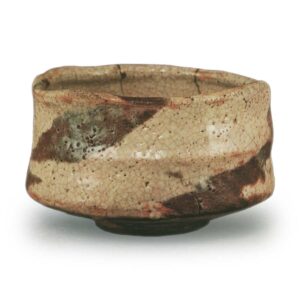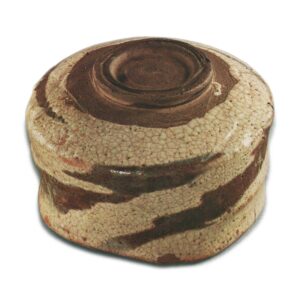

Height: 8.1-8.8cm
Diameter: 13.0-13.5cm
Outer diameter of foot ring: 6.7cm
Height of foot ring: 0.8cm
This tea bowl is almost the same as the Nezumi Shino bamboo-joint tea bowl. It was probably made at the Okaya Kamishimo kiln or the Muta-do kiln.
Neriage Shino is made by kneading red clay into white clay, and in some cases white clay is kneaded into red clay. It seems more appropriate to call it Neriage Shino.
Neriage-te Shino is also produced at the Muta-dō, Kamishita-gama, and Yūemon-gama kilns in Ōgaya, but the Takane Higashi-gama kiln is the best and produces the largest number of pieces.
This tea bowl is made by kneading red clay into white clay. The red clay appears beautifully, like flowing clouds or a flowing water pattern in a painting, and it is probably named “Mouko” (fierce tiger) because it resembles the spots of a tiger. The iron-colored glaze is mixed with a mouse-colored glaze in places, and it is soft but strong, with orange-colored flames visible around the mouth and at the protruding waist. The glaze is also slightly reddish, and the finish is excellent.
The shape is very similar to that of a Nezumi Shino bamboo shoot tea bowl. The strong, large, protruding waist curves gently upwards to the rim, which is held in place by the body of the bowl, which is exactly the same size as the bamboo shoot. The thick, mountain-path-like rim is uneven, with some parts curving outwards and others not, giving it a very strong appearance.
The foot ring is a round double foot ring with a stick inserted into the tatami mat. The way the kneaded red clay is cut, the gap at the base, and the way the clay is pressed on the inside suggest that it is probably a foot ring. The Yamamichi stick is also slowly turned around the base from the foot ring to the waist.
There is one small repair on the waist, and one gold repair on the rim. There are also two vertical grooves.
The interior is spirally shaped and spacious, and there is a concave line in the center of the interior that corresponds to the nodes of the bamboo on the outside. There are also a few tiger spots, but they do not feel too noisy.
The inner box is black lacquered, and the gold-powdered characters on the lid are by Iki Sansaisai. There is a calligraphy by Koboku Ryonin on the underside of the lid. Sansaisai was a retainer of the lord of Okayama Ikeda, and in the first year of the Genji era, he was the main person who stopped the Shogunate’s invasion of Choshu. After the Meiji Restoration, he retired from public service and spent his later years enjoying the arts and literature, and was known as the owner of the best collection of tea utensils in the Chugoku region.
On the inside of the lid of the box, there is a note written by Masuda Don’o that says, “Sankei says that a fierce tiger is the same as a blind tiger. There is a reason for this saying.” It is said that Hara Sankei once fell for a fake Iga Garan incense container, and when he used this tea bowl for a tea ceremony afterwards, Don’o said that Hara belonged to him.
There is also a note by Kobori Enshu on the back of the outer box lid.



